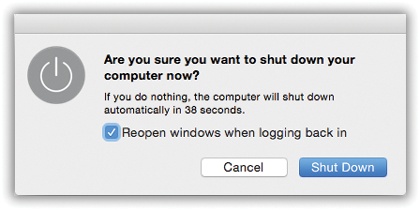If you’re the only person who uses your Mac, finishing up a work session is simple. You can either turn off the machine or simply let it go to sleep, in any of several ways.
If you’re shutting down your Mac every night, you may be doing a lot more waiting than necessary. Sleep mode consumes very little power, keeps everything you were doing open and available, and wakes up almost immediately.
To make your machine sleep, do one of the following:
Close the lid. (Hint: This tip works primarily on laptops.)
Press the power button (
 ) on your Mac. Tapping that button (for about a half-second) makes any kind of Mac drop off to sleep instantly.
) on your Mac. Tapping that button (for about a half-second) makes any kind of Mac drop off to sleep instantly.Hold down the power button (
 ) for 2 seconds. You get the box shown in Figure 1-3; hit Sleep (or type S).
) for 2 seconds. You get the box shown in Figure 1-3; hit Sleep (or type S).Press Control-
 . In the dialog box shown in Figure 1-3, click Sleep (or type S).
. In the dialog box shown in Figure 1-3, click Sleep (or type S).Just walk away, confident that the Energy Saver setting in System Preferences will send the machine off to dreamland automatically at the specified time.
Tip
Ordinarily, closing your MacBook’s lid means putting it to sleep. And, ordinarily, putting it to sleep means cutting it off from the world. But OS X’s Power Nap feature lets your Mac stay connected to your network and to the Internet, even while it’s otherwise sleeping. It can download email, back up your stuff, download software updates, and so on. For details, see Scheduled Startup and Shutdown.
You shouldn’t have to restart the Mac very often—only in times of severe troubleshooting mystification, in fact. Here are a few ways to do it:
Choose
 →Restart. A confirmation dialog box appears; click Restart (or press Return).
→Restart. A confirmation dialog box appears; click Restart (or press Return).Press Control-
 (or hold down the
(or hold down the  button) to summon the dialog box shown in Figure 1-3; click Restart (or type R).
button) to summon the dialog box shown in Figure 1-3; click Restart (or type R).
To shut down your machine completely (when you don’t plan to use it for more than a couple of days, when you plan to transport it, and so on), do one of the following:
Press Control-Option-⌘-
 . (It’s not as complex as it looks—the first three keys are all in a tidy row to the left of the space bar.)
. (It’s not as complex as it looks—the first three keys are all in a tidy row to the left of the space bar.)Press Control-
 (or hold down the
(or hold down the  button) to summon the dialog box shown in Figure 1-3. Click Shut Down (or press Return).
button) to summon the dialog box shown in Figure 1-3. Click Shut Down (or press Return).Wait. If you’ve set up the Energy Saver preferences (Dictation & Speech) to shut down the Mac automatically at a specified time, then you don’t have to do anything.
In the Shut Down dialog box illustrated in Figure 1-3, you’ll notice a checkbox called “Reopen windows when logging back in.” That option does something very useful: The next time you start up your Mac, every running program, and every open window, will reopen exactly as it was at the moment you used the Restart or Shut Down command. The option gives the Mac something like the old Hibernate feature in Windows—and saves you a lot of reopening the next time you sit down to work.
If you turn off that checkbox, then your next startup will take you to the desktop, with no programs running. And if you want the Mac to stop asking—if you never want your programs and windows to reopen—then open ![]() →System Preferences→General and turn on “Close windows when quitting an app.”
→System Preferences→General and turn on “Close windows when quitting an app.”
If you share your Mac, then you should log out when you’re done. Doing so ensures that your stuff is safe from the evil and the clueless even when you’re out of the room. To do it, choose ![]() →Log Out Casey (or whatever your name is). Or, if you’re in a hurry, press Shift-⌘-Q.
→Log Out Casey (or whatever your name is). Or, if you’re in a hurry, press Shift-⌘-Q.
When the confirmation dialog box appears, click Log Out (or press Return) or just wait for 1 minute (a message performs the countdown for you). The Mac hides your world from view and displays the Log In dialog box, ready for its next victim.
Get Switching to the Mac: The Missing Manual, El Capitan Edition now with the O’Reilly learning platform.
O’Reilly members experience books, live events, courses curated by job role, and more from O’Reilly and nearly 200 top publishers.


